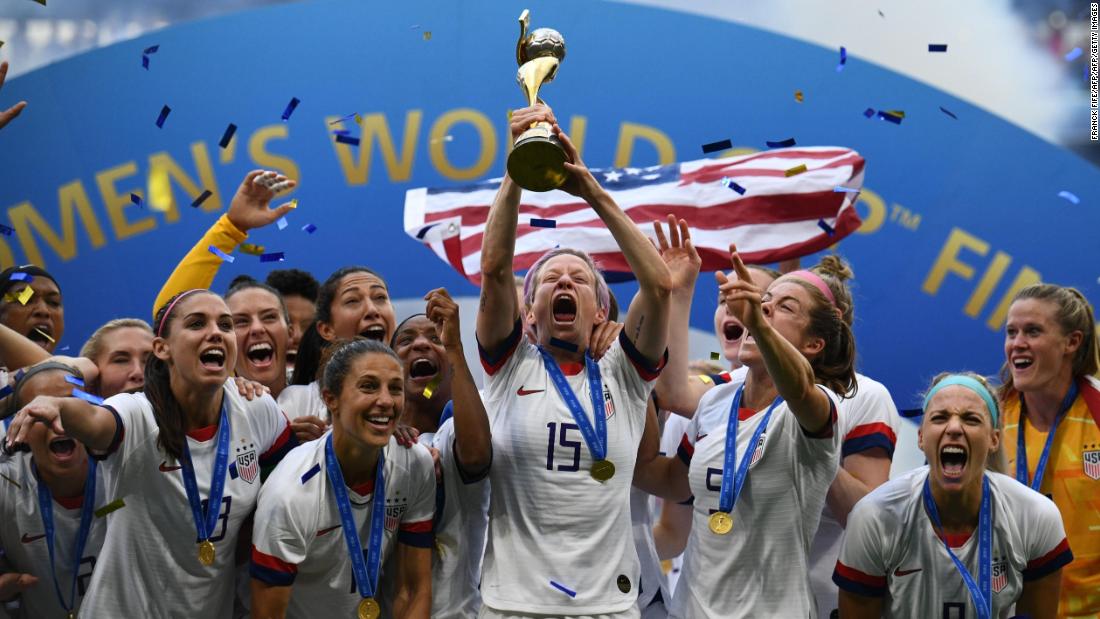The United States Women’s National Team proved that it is yet again, the greatest in the world.
But what isn’t the greatest in the world? The fact that these women are paid a fraction of the amount that the Men’s National Team would have made if they won the tournament. Plain and short, they need to be paid.
According to a study from the Guardian, the max earnings that a WNT member could make with a World Cup win is $200,000 while a MNT member could make up to $1.1 million.
These numbers are also in relation to the amount of money that FIFA gives to the winner of the tournament. France (men) won the cup in 2018 and received a total of $38 million. The U.S. (women) won the cup this year and received about $4 million. This shows that there is an underlying problem within FIFA.
After the USWNT won the World Cup on Sunday, “equal pay” chants erupted as the President of FIFA took the stage to award the team their medals.
Infantino on the stage. Whole stadium chants “EQUAL PAY” #FIFAWWC pic.twitter.com/WIn9OCMdbU
— Lou (@loutalksfutbol) July 7, 2019
On International Women’s Day, the USWNT filed a class action lawsuit against U.S. Soccer Federation claiming that they have consistently received less money for performing the same job as their male counterparts.
The WNT has had unmatched success on an international level. The USWNT has medaled in every FIFA Women’s World Cup, including four gold medals (the past two have come in back to back years).
Since the installment of Women’s Soccer in the Olympic Games in 1996, the WNT has reached the finals every year except for 2016. They were eliminated in the quarterfinals due to a penalty shootout with Sweden.
In the CONCACAF Championship and Gold Cup, they have won every year except for 2010 when they placed third.
Now, the men participate in the exact same tournaments.
The men’s team has been competing in the FIFA Men’s World Cup since 1930. The last time they medaled in the tournament was 1930. They did not even qualify in 2018.
The Men’s National Team doesn’t even compete in the Olympics. They always use an Under-23 team. However, the U-23 team hasn’t even qualified for the Olympics in the past two years. The best that this team has placed is fourth in 2000.
The CONCACAF Championship and Gold Cup have been a great tournament for the MNT, however. Since their first appearance in 1985, they have won the tournament six times and been the runners-up six times (including this year).
The WNT has clearly obtained more accolades for the USSF in the shorter number of years that they have been competing at a national level.
So why aren’t they paid at least the same amount?
They compete in mostly the same events (give or take a few, which the USWNT has dominated and the USMNT has sadly not).
This issue showcases the underlying issue of equal pay, which unfortunately isn’t a reality everywhere in this country.
The women do make money, but most of it comes from endorsements. Brands such as Nike, Adidas, Puma, as well as many others have sponsored athletes that help to make their brands more attractive to an audience.
One major money-maker has been the number of jerseys that the USWNT has sold on Nike’s website. Their home jerseys have sold more than any other men’s or women’s jersey.
Also, looking specifically at game revenue, the women’s team has knocked it out of the park in comparison to the men’s team.
Game revenue isn’t everything though, and it should be noted that a new collective bargaining agreement was brought into the USSF in 2017. This new collective bargaining agreement significantly impacts the WNT because it begins to close the pay gap between the teams.
In a new Washington Post article, the collective bargaining agreement is explained like this:
If both teams played 20 friendlies in a year, a top-tier women’s national team player would earn $164,320 less, or 38% of the compensation of a similarly situated MNT player,” under the old agreement. Under the new agreement, “using the same 20-game scenario, we calculated the player on the women’s team would earn $28,333 less or about 89 percent of the compensation of a similarly situated men’s team player. If both teams lost all 20 games, the players would make the same amount.
The women’s team and men’s team are paid differently, both numbers wise and the way that they are paid. Women are paid a base salary, whereas men are paid strictly on bonuses (if they win a game they make a certain amount and if they lose a game they make a certain amount).
However, that doesn’t change the fact that in a World Cup qualifying tournament, men are paid more for a loss than women are paid for a win.
Like I’ve said earlier, this is also FIFA’s fault for not allotting more money for the women’s tournament. But that doesn’t mean that the sexism in FIFA can justify the sexism in the USSF.
The women’s team is making steps in the right direction, but there is still so much work to be done. This fight is not over, and won’t be over until FIFA recognizes the sexism in their organization and changes.
These women cannot fight alone. I implore more men’s national team players as well as men’s players from across the globe to fight for these women.
This is bigger than soccer. This is bigger than women’s sports. This is a reality for women all over the world who are making less than their male counterparts. It is time to change. It is time for women to get the money that they deserve.
And it starts with the United States Women’s National Team.







